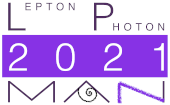Conveners
Neutrino physics: Poster session
- There are no conveners in this block
Neutrino physics: Parallel 1
- Andrzej Michal Szelc (University of Manchester (GB))
Neutrino physics: Parallel 2
- Kendall Mahn (Michigan State University)
Neutrino physics: 1
- Ewa Rondio (National Centre for Nuclear Research (PL))
Neutrino physics: 2
- Andrzej Michal Szelc (University of Manchester (GB))
Neutrino physics: 3
- Ewa Rondio (National Centre for Nuclear Research (PL))
Neutrinos propagating through matter behaves like an open-quantum system. These neutrinos interact with the environment via weak coupling. It leads to a loss of coherence of the neutrino mass states. We generally observe this phenomenon of decoherence in systems interacting with a dissipative environment. In this present work, we are exploring how environmental decoherence affects neutrino...
The next generation long-baseline neutrino oscillation experiment, Hyper-Kamiokande, will consist of a 260 kt underground water Cherenkov detector, placed 295 km from the neutrino source at J-PARC. This is generated by a 1.3 MW proton beam striking a target. In addition, a suite of near detectors, both on and off-axis will be used. With this, Hyper-Kamiokande aims to perform precision...
The discovery of the phenomena of neutrino oscillation was the first clear evidence of physics beyond the Standard Model (SM). It requires as extension of the SM to explain the masses and mixing of neutrinos. The models explaining beyond SM (BSM) physics naturally comes with some additional unknown interactions of neutrinos which are beyong the scope of SM, often called as Non Standard...
The T2K experiment measures the neutrino oscillation parameters by observing $\nu_\mu$ ($\bar{\nu}_\mu$) disappearance and $\nu_e$ ($\bar{\nu}_e$) appearance from a $\nu_\mu$($\bar{\nu}_\mu$) beam. The events are observed in the near detector ND280 and the far detector Super--Kamiokande (SK) situated at 280 m and 295 km respectively from the beam production target. In SK, the products of $\nu$...
We propose a new approach to explore the neutral-current non-standard neutrino interactions (NSI) in atmospheric neutrino experiments using oscillation dips and valleys in reconstructed muon observables, at a detector like ICAL that can identify the muon charge. We focus on the flavor-changing NSI parameter $\varepsilon_{\mu\tau}$, which has the maximum impact on the muon survival probability...
Global analyses [[1][1]-[3][2]] of the existing neutrino oscillation data point to near--percent-level relative $1\sigma$-precision in oscillation parameters such as $\vert \Delta m^2_{31} \vert $ $ \left(1.1\%\right)$, $\Delta m^2_{21} $ $ \left(2.3\%\right)$, $\sin^2\theta_{13} $ $\left(3.0\%\right)$ and $\sin^2\theta_{12}\left(4.5\%\right)$. All these analyses show a preference for the...
CPT invariance is one of the most fundamental symmetries in nature and it plays a major role in the formulation of Quantum Field Theory. Although no definitive signal of CPT violation has been observed so far, there are many reasons to carefully investigate various low-energy phenomena that can provide better probes to test CPT symmetry. In this context, neutrino experiments are expected to...
The Hyper-Kamiokande experiment consists of a 260 kt underground water Cherenkov detector with a fiducial volume more than 8 times larger than that of Super-Kamiokande. It will serve both as a far detector of a long-baseline neutrino experiment and an observatory for astrophysical neutrinos and rare decays.
The long-baseline neutrino experiment will detect neutrinos originating from the...
NOvA is a long-baseline, accelerator neutrino experiment measuring oscillation and interaction physics. The NuMI beam at Fermilab is used to generate muon neutrinos that pass in their unoscillated state through the Near Detector, located at Fermilab, and the Far Detector 810 km away in Ash River, Minnesota. NOvA studies the muon neutrino deficit and electron neutrino excess with both neutrino...
T2K is a long baseline experiment providing world-leading measurements of the parameters governing neutrino oscillation. T2K data enable the first 3 sigma exclusion for some intervals of the CP-violating phase \delta_{CP} and precision measurements of the atmospheric parameters \Delta_m^{2}{32}, sin^2(\theta{23}).
T2K exploits a beam of muon neutrinos and antineutrinos at the Japan Particle...
Jiangmen Underground Neutrino Observatory (JUNO) is a liquid scintillator based neutrino experiment, being built in the Guangdong province in southern China. Its construction is expected to be completed in 2022. The experimental hall is located underground, below a 700 meter rock over-burden, to reduce backgrounds from cosmic rays.
The JUNO primary scientific goal consists in the...
The Short-Baseline Near Detector (SBND) will be one of three liquid Argon Time Projection Chamber (LArTPC) neutrino detectors positioned along the axis of the Booster Neutrino Beam (BNB) at Fermilab, as part of the Short-Baseline Neutrino (SBN) Program. The detector is currently in the construction phase and is anticipated to begin operation the second half of 2022. SBND is characterised by...
SNO+ is a multi-purpose neutrino experiment located at SNOLAB. Following a commissioning phase with water as a detecting medium, SNO+ is now filled with liquid scintillator. We are studying backgrounds in the detector and embarking on a neutrino physics program including reactor, geo and solar neutrinos. Preparations are also underway to deploy roughly 4 tonnes of tellurium (0.5%) in the...
MicroBooNE is a liquid argon time projection chamber that operates in the Booster Neutrino Beam at Fermilab. The detector provides high-resolution imaging of neutrino interactions with a low threshold and full angular coverage. Thanks to a high event rate and several years of continuous operation, the MicroBooNE collaboration has obtained the world's largest dataset of neutrino-argon...
The NA62 experiment at CERN reports searches for K+ → e+N, K+→μ+N and K+→μ+νX decays, where N and X are massive invisible particles, using the 2016-2018 data set. The N particle is assumed to be a heavy neutral lepton, and the results are expressed as upper limits of O(10−9) and O(10−8) of the neutrino mixing parameter |Ue4|2 and |Uμ4|2, improving on the earlier searches for heavy neutral...
The MicroBooNE experiment is performing a series of measurements to address the nature of the excess of low energy electromagnetic interactions observed by the MiniBooNE collaboration. One analysis looks for neutrino-induced neutral current (NC) resonant Delta(1232) baryon production followed by Delta radiative decay from the Fermilab Booster neutrino beam, while three others look for electron...
